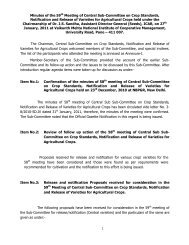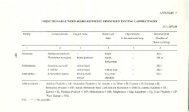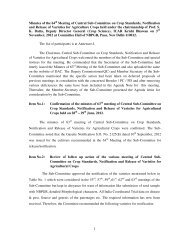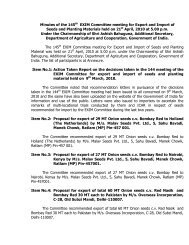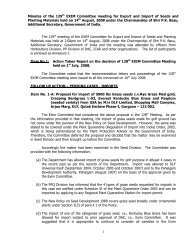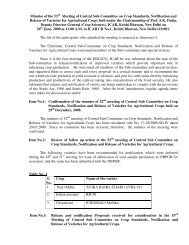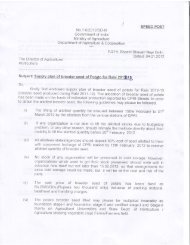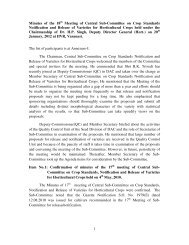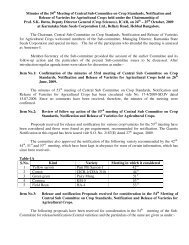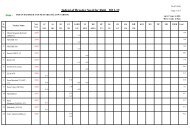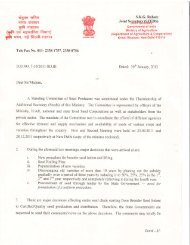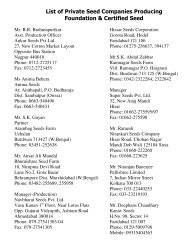2. SEED SAMPLING - SeedNet
2. SEED SAMPLING - SeedNet
2. SEED SAMPLING - SeedNet
Create successful ePaper yourself
Turn your PDF publications into a flip-book with our unique Google optimized e-Paper software.
<strong>2.</strong> <strong>SEED</strong> <strong>SAMPLING</strong><br />
RL. AGRA w.4.L<br />
Seed sampling is aimed at obtaining a sample of the required size and<br />
consisting of the same components as the whole lot of seeds. The quantity of seed<br />
tested in the laboratory is small, compared with the size of the seed lot which it is<br />
intended to represent. No matter how accurately the laboratory work is done, the<br />
resultscan only show thequality of the sample submitted for analysis. Consequently.<br />
every effort must be made to ensure that the sample sent to the seed testing<br />
laboratory accurately represents the seed lot in question. Seed Testing Laboratory<br />
personnels are not necessarily engaged in the sampling of seeds. But, nevertheless<br />
they should be well acquainted with the principles of seed sampling and should<br />
also be able to guide properly the p;rsons engaged in this job.<br />
INSTRUMENTS AND SUPPLIES REQUIRED FOR <strong>SAMPLING</strong><br />
1. Stick of sleeve-type trier (Bag trier)<br />
Stick of sleeve-type trier consists of a hollow brass tube inside a closely fitting<br />
outer shell or sleeve which has a solid pointed end. The tube and sleeve have open<br />
slots in their walls so that when the tube is turned until the slots in the tube and<br />
sleeve are in line, seeds can flow into the cavity of the tube, and when the tube is<br />
given a half turn the openings are closed. "Thetubes vary in length and diameter<br />
and are made with or without partitions for different kinds of seeds (For clovers<br />
and other small free-flowing seeds packed in bags 762 mm trier with outside<br />
diamete of 1<strong>2.</strong>7 mm and nine slots; and for cereals, 762 mm trier with outside<br />
diameterof 25.4 mm and six slots have been foundmoresuitable).lbis trieris used<br />
for drawing seed samples from the seed lots packed in bags or containers.<br />
<strong>2.</strong> Bin sampler<br />
Bin samplers are constructed on the same principle as bag triers but are much<br />
larger. ranging up to 1600 mm in length and 38 mm in diameter with six or nine<br />
slots. These samplers are used for drawing samples from the lots stored in the bins.<br />
5
3. Nobbo trier<br />
This trier is made in different dimensions to suit various kinds of seeds. It is a<br />
pointed tube, long enough to reach the centre of the bag, with an oval hole near the<br />
pointed end. The total length of the instrument should be aproximately 500 mm<br />
including a handle of about 100 mm and a point of about 60 mm leaving about 310<br />
mm to penetrate into the bage, which should be sufficient to reach the centre of all<br />
types of bags. For cereals the intemal diameter of the tube should be about 14 mm<br />
but for clovers and similar seeds 10 mm is sufficient.<br />
The Nobbo trier is suitable for sampling seed in bags but not in bulle<br />
4. Miscellaneous supplies<br />
This includes sample pans, bucket, stapler, sewing needles and thread, a piece<br />
of canvas (1 m x 1 m), sealing device, sam pIe bags, replacement labels and sealing<br />
tape (duly authenticated), hand lens, scissors, flash light and packing materials,<br />
stationery and stamps etc. .<br />
A kit containing large and small sampling triers and misccllimoous supplies<br />
described above is a must for seed samplers to perform their job satisfactorily.<br />
GENERALPIDNCWLES OF SAMPLlliG<br />
,<br />
1. Sampling should be carried out only by persons trained and experienced in<br />
seed sampling and employed by the official organisations.<br />
<strong>2.</strong> The seed lot shall be so arranged that each individual container or part of<br />
the lot is conveniently accessible. Upon request by the sampler, the owner shall<br />
provide full information regarding the bulking and mixing of the lot. When there<br />
is definite evidence of heterogeneity sampling should be reduced. In case of doubt,<br />
heterogeneity can be tested (Refer Appendix Chapter 9 ).<br />
3. Thesize of the seed lot should also not exceed maximum seed lot size limits<br />
prescribed in Table <strong>2.</strong>1 subject to a tolerance of 5%.<br />
4. When sampling is being done by hand, great care should be taken to keep<br />
the fingers tightly closed around the seeds so that none may e.scape.Seed sampler<br />
may request that bags be emptied or partially emptied to facilitate sampling. The<br />
6
ags may then be refilled. Thismay be necessary since it is impossible to obtain<br />
sampledeeper than 400 mm that is, from the lower layers in bags and bins.<br />
I 5.Other things being equal, a large sample is more representative of a lot than<br />
is a small sample. Moreover, if there is a choice as to whether to reduce a sample<br />
before sending it to the laboratory, the larger quantity should be submitted.<br />
6. The sampler should determine that all seed bags sampled are identified as<br />
belongingto a single lot, either by a label or stencil mark on the bag.<br />
7. The sampler must sample the minimum requisite number of bags from the<br />
seed lot. The sampling intensity must not be less than that prescribed below.<br />
(i) For seed lots in bags (or containers of similar capacity that are uniform in<br />
size). The Following sampling intensity is regarded as the minimum requirements.<br />
Up to 5 containers Sample each container and always take at least<br />
five primary samples.<br />
6-30 containers Sample five containers or at least one in every<br />
three containers, whichever is the greater.<br />
31-4OQ'containers Sample 10 containers or at least one in-every<br />
five containers, whichever is the greater.<br />
401 or more containers Sample 80 containers or at least one in every<br />
seven containers, whichever is greater.<br />
(ii) For small containers: When the seed is in small containers such as tins,<br />
cartons, or packets'as used in the retail trade, the following procedure should be<br />
adopted.<br />
A 100 kg weight of seed is taken as the basic unit and the small containers are<br />
combined to form sampling units not exceeding this weight, e.g. 20 containers of<br />
)<br />
5 kg, 33 containers of3 kg or 100 containers of 1 kg. For sampling purposes, each<br />
unit is regarded as one container and the sampling intensity prescribed earlier is<br />
applied.<br />
(iii)Forothercontainers/processingline: When sampling seed from any other<br />
7
~--~<br />
kind of container or from streams of seed entering containers the following shall<br />
be regarded as the minimum requirement.<br />
Lot Size Number of primary samples to be taken<br />
Up to 500 kg At least five primary samples.<br />
501-3,000 kg One primary sample for each 300 kg, but not<br />
less than five primary samples.<br />
3,001-20,000 kg One primary sample for each 500 kg. but not<br />
less than 10 primary samples.<br />
20,001 and above One primary sample for each 700 kg, but not<br />
less than 40 primary samples.<br />
8. Care must be exercised in reducing composite samples. Careless splitting<br />
of the sample cannot be expected to produce two similar portions.<br />
9. Any seed known to have been treated with a poisonous fungicide should be<br />
identified so that the person who subsequently may handle the sample will be<br />
infonned of the potential hazard.<br />
10. While taking samples from machine sewed cotton bags, a few stitches at<br />
,oneof the top comers can be loosenlbroken and then this break can pe closed with<br />
hand stapling device after the contents of the bag have been sampled or a self<br />
adhesive label shall be affixed to ensure proper sealing and to avoid a tampering.<br />
11. The weight of the sample drawn should not be less than the weight of the<br />
submitted sample prescribed in the Table <strong>2.</strong>1.<br />
MEmOD OF OBTAINING PRIMARY SAMPLES<br />
The primary samples are drawn with the aid of suitable seed triers/or by hand<br />
in case of chaffy/non free-flowing seeds.<br />
When the lot is in bags, the bags to be sampled should be selected at random<br />
throughout the lot and primary samples drawn by inserting the trier gently into the<br />
bags, pointing upwards at an angle of about 30 to the horizontal, with the hole<br />
facing downward until it reaches the centre of the bag. The trier is then revolved<br />
8
I<br />
through 180, bringing the hole to nice upwards, and is withdrawn with decreasing<br />
speed so that the quantity of seed obtained from successive locations increases<br />
progressively from centre to the side of the bag. The seed so withdrawn is em ptied<br />
into a seed pan/or on a piece of cl()th. While the trier is being withdrawn it should<br />
be gently agitated sO that an even flow of seed is maintained. The sampling should<br />
be varied from top. middle and bottom of the bags. After the trier has been removed<br />
the point should be run across the hole a couple of limes in opposite directions to<br />
pun the threads together and close the holc.<br />
Closed paper bags may also be sampled in this manner. Thc hole in paper bags<br />
however, should be closed with a self adhesive tape duly signed by the sampler.<br />
When the lot is in bulk, or in large containers, the primary samples should be<br />
drawn with the aid of bin sampler from random positions and depths. The vertical<br />
insertion is more practicable. The tricr is thrust into the bag/bin/bulk in the closed<br />
position, then opened and turned a couple of times or gently agitated to aHowit to<br />
fillcompletely.Thereafter, it isclosed again, withdrawnand emptiedjn to a suitable<br />
seed pan/cloth. Cme should be taken in closing the trier so that seeds are not<br />
damaged.<br />
In the case of chaffy seed,; that have not been rendered free flowing, the<br />
primarysamples are drawn by hand.<br />
When seed is packed in small. or moisture-proof containers (e.g. tins, or plastic<br />
bags). it should, if possible. be sam pled before the seed enters the containers. When<br />
this has not been done, a sufficient number of containers shaH be opened or pierced<br />
for abstraction of primary samples. The sampled containers shall then be closed or<br />
the contents transferred to new containers.<br />
Seedsarealso sampled as it enters the containers, that is, at the time processed<br />
seeds are being put in the containers. This can be done with the help of an automatic<br />
device or manually. An uniform quantity of seed may be taken from the seed stream<br />
at specified. intervals.<br />
METHOD OF PREPARING COMPOSITE SAMPLES/SUBMITTEI><br />
SAMPLES<br />
When the primary samples appear uniform they arc combined and thoroughly<br />
mixed to form the composite sample. From composite sample. "ubmittedsamplc<br />
9
of rcquisitc weight or more is obtained either by repecited halving or by abstracting<br />
and subsequently combining small random portions.<br />
HES])ATCIIOF SURMITfEH SAMI)LE<br />
Each submitted sample should be sealed and marked in a way that establishes<br />
connection between seed lot and the seed sample. The label should contain all the<br />
necessary detail such as variety, class of seed, quantity in the lot, to whom it<br />
belongs. name of producer, seed treatment, date of hmvesting and threshing, if<br />
known, sampled by, date of sampling and the kind of tests required.<br />
After marking the sample. it should be packed so as to preyent damage during<br />
transit. For germination tests it should be packed prererably in cloth bag. For<br />
detcrminat ion of moisture content it should be packed separately in moisture-proof<br />
containers from which as much air as possible has been excluded.<br />
Samples should be despatched by the sampler to the seed testing laboratory<br />
without delay.<br />
<strong>SAMPLING</strong> IN <strong>SEED</strong> TESTING LABORATORY<br />
The seed samples received in the laboratory (submitted samples*) are required<br />
to be reduced to obtain Working sampJes for carrying out various tests. A number<br />
of methods arc available for obtaining Working samples.<br />
1. Mechanicaldivider method<br />
This method is suitable for all kinds of seeds, except the extremely chaffy<br />
types. In this method. the sample is mechanically divided by theseed dividers (the<br />
available lypcs arc Bocrner and Gamet Seed ~eividers). the apparatus divides a<br />
sample passedthrough it intotwoapproximately equal parts.The submitted sample<br />
can be mixed by passing it through the divider, recombining the two parts and'<br />
passing the whole sample through a second timc, and similarly, a third timc, if<br />
* When a submittcd sample smaller than prescribed weight is received in the seed laboratory<br />
the sampler may be notified aa;ordingly and analysis withheld until sufficicnt seed is<br />
received. However, in the case of very expensive seed, the analysis may be completed to the<br />
extent possible and the following statement inserted on the certificate "TIlc sample submitted<br />
weighed only and is not in aa;ordance with the size prescribed in the Rules for Seed<br />
Testing".<br />
10
necessary. The s,lmple is redpcecJ by passing the seed thropgh repeatedly an?<br />
removing one hall' on each occasion. "Ihis process.of successive halving is con-<br />
tinued. until a working sample of approximately. but not less than. the required size<br />
is obtained.<br />
<strong>2.</strong> Randomcups method<br />
This method is particulafly suitable rorseeds requiring a working-sample upto<br />
1() gm provided that they arc not or extrem Iy chatTy structure, and provided that<br />
theydo notbounce or roll (like fJrassica spp.)<br />
In principle. six to eight small cups. or thimbles, arc placed al random on a<br />
tray. After a preliminary mixing the seed is poured unilor/TIly,over the tray. 'Ioe<br />
seed that fallsinto the cups is taken as the working sample.<br />
3. ModifiedhalYin~method<br />
The apparatus comprises or a tray into which is fitted a grid of equal sized<br />
cubical cells. open at the top and evcry alternate one having no bottom. Arter<br />
preliminarymixing. the seed is poured evenly over the grid in the same way as it<br />
is poured in the random cups method. When the grid is lifted. approximately hall'<br />
thesamplcremainson the tray. Toe submitted sample is successively halved inthis<br />
way until a working sample approximately. but not less than, th(>rcquiredsize is<br />
obtained.<br />
4. Spoon method<br />
It is permissibleto use this method only [or samples of a single small-seeded<br />
species.A tray.spatula and a spoon with a straightedge arc required.Arter<br />
preliminarymixing. the seed is poured evenly over the tray in the same way as it<br />
is poured in tIlerandom cups method. The tray should not be shaken thereafter.<br />
Withthespoon in one hand. the spatula in the other, and using both, small portions<br />
of seed rromnot less than rive random place..')on the tray should be removed.<br />
Sufficientportionsof seed arc taken to constitute a working sampicof approximately,but<br />
not less than. the required size.<br />
S. The hand halving method<br />
This method is restricted to the following ~enera of elm ffy seeds :1\ndropo!jon,<br />
11
Arrhcnatherum, Astreblc, Cenchrus, Chloris, Dichanthium, Stylosanthes (not<br />
guianensis), l'risctum
<strong>SEED</strong> SAJ'V1J»LlNG" SI)ECIMEN<br />
Label on which detailed information about the seed lot may be provided and put<br />
in the bag.<br />
., ".................................................................................................................<br />
Date ,..... Sampled by ;........<br />
Sender'sNamc ;.................................................................................<br />
Address "<br />
.............<br />
, ,.............<br />
KindofculLiver/hybrid.............................................................................................<br />
Classofsccd , ".............<br />
LotNumber , ....................................................<br />
Whether treated: Yes/No<br />
Quantityof seed in lot ,................................................<br />
Dateof harvesting& threshing (if known) """""""""""""""""""""""""""""""<br />
Kind of Test Required'<br />
" ,...........<br />
Pleasecheck: Purity, Germination, TZ, Moisture, Field Plot test,<br />
Seed health, any other (Please name)<br />
. Remarks : """""""""""""""""""""'"<br />
Sampledby: "...............<br />
...............................................................................................................................<br />
13<br />
Signature
Table <strong>2.</strong>1. Lot and sample weights<br />
Maximum Minimum wt. of<br />
wLof<br />
seed lot Submitted Work- Work-<br />
Crop Botanical (kg) sample ing ing<br />
name (g) sample sample<br />
for purity col1nlof<br />
analysis other spe-<br />
(g) ciesseed<br />
(g)<br />
2 3 4 5 6<br />
FIELD CROI)S<br />
Cereals<br />
Barley Hordeum FUlgare 20,000 1000 120 1000<br />
Paddy Ol}'za satiFa 20.000 400 40 400<br />
Triticale X. Triticosecale<br />
Wiltmack<br />
20,000 lOOO 120 1000<br />
Wheat<br />
Millets<br />
Triticum aestivum 20,000 1000 1.20 1000<br />
Barnyardmillet Ecillochloa cololla 10,000 SO 8 SO<br />
Commonmillet<br />
(Proso millet,<br />
Hogmillet)<br />
Pallicum miliaceum 10,000 150 15 150<br />
Fingermillet Eleusine coracalla 10,000 60 6 60<br />
Italianmillet<br />
(Fox tail millet<br />
Setaria italica 10,000 90 9 90<br />
Kodomillet Pmpalum<br />
scrobiculatum<br />
10,000 SO 8 80<br />
Littlemillet Pall/cum sumatrellse<br />
(P. miliare)<br />
10,000 70 7 70<br />
Maize lea mays 40,000 1000 900 1000<br />
Pearl millet Pell/lisetum<br />
americanum<br />
10,000 150 15 150<br />
Sorghum<br />
Pulses<br />
Sorghum bicolor 10,000 .900 90 900<br />
Bengal gram Cicer arietinum 20,000 1000 1000 1000<br />
14
2 .i 4 5 6<br />
mack gram Vigna /11//ngo 20,000 1000 150 1000<br />
Chkkling veKh Lathyrus salims 20,000 1000 450 1000<br />
Cowpea Vigna unguiculata 20,000 1000 400 1000<br />
French bean Phaseolus I'li/garis 20.000 1000 700 1000<br />
(Raj Mash)<br />
Green gram Vigna radial a 20,000 1000 120 WOO<br />
Horse gram Macro/yloma 20,000 500 500 500<br />
(Kulthi) uni/7orll/l1<br />
Indian bean l.a/1 lab P1l11JlI1-etls 20.000 1000 500 1000<br />
(Sem)<br />
Kidney bean Vigna aconilifolia 20,000 750 75 750<br />
(Moth bean)<br />
Lentil Ifl/s culillaris 10,000 600 60 600<br />
Pea PiSU/11 .\'a/il'u111 20,000 1000 900 1000<br />
Pigeon pea Cajanus cajan 20,000 1000 300 1000<br />
Oilseeds<br />
'Castor Ricinus communis 20,000 1000 1000 1000<br />
Groundnut Arachis hypogaea 20,000 1000 1000 1000<br />
(pods)<br />
Groundnut<br />
(kernels)<br />
Arachis hypogaca 20,000 1000 600 1000<br />
Linseed 1.inu/11usitmissimum 10,000 300 30 300<br />
Niger<br />
(Ram til)<br />
Guizolia abyssinica 10,000 150 15 150<br />
Rapeand<br />
Mustard<br />
Brassica spp '" 10.000 160 16 160<br />
Rocket sated Eruca I'esicana 10,000 40 4 40<br />
(Tara mira) (E. salim)<br />
Safflower Carthamus IiI/clonus 10,000 1000 180 1000<br />
Sesame Scsamum indicum 10,000 70 7 70<br />
Soybean Glycinc max 20,000 1000 500 1000<br />
/Sunflower<br />
(varieties)<br />
JIclianillUs (//l/IUS 20,000 1000 250 1000<br />
Sunflower lie/ianlhus all/IUS 20,000 250 125 250<br />
I (Hybrids)<br />
15
Fibre Crops<br />
I Cotton<br />
varieties<br />
(delinted)<br />
/ Cotton<br />
(Linted)<br />
/ Cotton hybrids<br />
(detinted)<br />
i Cotton hybrids<br />
(tinted)<br />
.lute(paisan)<br />
Roselle<br />
(Mesta)<br />
Sunnhemp<br />
Forage Crops<br />
Birdwood grass<br />
(Dhaman)<br />
Blue panic<br />
Buffel grass.<br />
Cluster bean<br />
Dharaf grass<br />
Doob<br />
Egyptian<br />
clover<br />
(Berseem)<br />
Fenugreek<br />
(Methi)<br />
Guinea grass<br />
Indian clover<br />
(Sweet clover,<br />
Senji)<br />
Lucerne<br />
2<br />
Goss)'pium spp.':'<br />
Gossypium spp."<br />
Gos.\ypium spp.*<br />
. Gos.\ypium spp.*<br />
Corchorus spp.*<br />
Hibiscus spp.***<br />
Crotalaria jullcea<br />
Cellchrus setigerus<br />
Panicum antidotale<br />
Cenchrus ciliaris<br />
Cyamopsis<br />
tetragolloloba<br />
ChrysopogOlIfulvus<br />
CYllodondactylol1<br />
Trifolium<br />
alexalldrillum<br />
Trigollella spp.<br />
Pallicum manmum<br />
Me/notus indica<br />
Medicago sativa<br />
3<br />
20,000<br />
20,000<br />
20,000<br />
20,000<br />
10,000<br />
10,000<br />
10,000<br />
20,000<br />
10,000<br />
10,000<br />
20,000<br />
10,000<br />
10,000<br />
10,000<br />
10,000<br />
10.000<br />
10,000<br />
10,000<br />
16<br />
350<br />
1000<br />
4 5<br />
250<br />
350<br />
100<br />
700<br />
700<br />
25<br />
25 2 20<br />
25 3 25<br />
1000 100 1000<br />
25<br />
60<br />
40<br />
~5<br />
100<br />
50<br />
35<br />
350<br />
25<br />
35<br />
10<br />
70<br />
70<br />
350<br />
1000<br />
250<br />
350<br />
100<br />
700<br />
700<br />
3 25<br />
1<br />
6<br />
10<br />
60<br />
4 40<br />
2 20<br />
10 100<br />
5 50<br />
6 --
2 3 4 5 6<br />
Marvel grass Dichmzthiul11 10,000 30 3 30<br />
alllwlatu/11<br />
Napier grass Pellllisetum spp. 10,000 ISO 15 150<br />
Oat Avella saliva 20,000 1000 120 1000<br />
Paragrass Brachia/"G l11ulica 10,000 30 3 30<br />
Rice bean Viglla umbel/ala 10,000<br />
(Red bean)<br />
Setaria grass Setaria allceps 10,000 25 2 20<br />
(Nandi grass)<br />
Shaflal Trifolium 10,000 25 2 20<br />
reSUpil1alUm<br />
Stylo Stylosalltlri;s spp. 10,000 70 7 70<br />
Sudangrass Sorghum sudallellSe 10,000 250 25 250<br />
Teosinte Euchlaella l11exicana 20,000 1000 900 1000<br />
Velvetbean Stizelobium spp. 20,000 500 50 500<br />
Venezuela Melillis minutiflora 10,000 25 5 25<br />
grass<br />
Green Manureand Miscellaneous Crops<br />
Dhaincha Sesballia callnabilla 20,000 900 90 900<br />
Hemp Canllabissativa 10,000 600 60 600<br />
Indigo Illdigofera tillctoria 20,000 600 60 600<br />
Poppy Papaver somniferum 10,000 25 1 10<br />
Sugarbeet Beta vulgaris 20,000 500 SO 500<br />
Tobacco Nicotialla spp. 10,000 25 0.5 5<br />
VEGETABLES<br />
Cucurbits<br />
Ashgourd Bel/il1casacaifere 20,000 700 70 700<br />
Bittergourd Momordica clzaralltia 20,000 1000 450 WOO<br />
Boltlegourd Lagel1ariaSlcerana<br />
L. leucallllza<br />
20,000 700 70 700<br />
Chow-chow Sechium edule 40,000 250 25 250<br />
fruits fruits<br />
17
:2 :i 4 5 6<br />
Cucumber Cucumis S({I{FUS 10,000 150 70 150<br />
Indian squash l'raccil ru!/us.flSIu/osus 20.000 ]000 250 1000<br />
Little gourLi Cocl'illia graJl(/is 10,000 250 25 - 250<br />
'Planting stakes PI. stakcs<br />
Long melon Cucumis me!o 10,000 150 70 1.50<br />
Musk mclon Ci{CI,lInisme!o 1(1.000 150 70 1.50<br />
PointeLi gourLi hic!tosalll!tcs dioica 10,000 700 70 700<br />
Pumpkin Cucurbila mosc!ta(a 10,000 350 180 350<br />
(Kashiphal)<br />
Ridge gourLi I,u/lcl aculallgu/a 20.000 1000 400 1000<br />
Snakc gourLi J'riclwsalll/1/IS anguilla 20.000 1000 250 1000<br />
Snap mclon Cucumis me/o 1.0.000 150 70 150<br />
Sponge gourLi LuJra cy/illdric({ 20,000 1000 250 1000<br />
Summcr squash Cucurbjla pepo 20,000 1000 700 1000<br />
Water mclon Citrullu.l'lallalUS 20,000 1000 250 1000<br />
Winter squash Cucurbita maxima 20,000 1000 700 1000<br />
Fnlit Vegetables<br />
Brinjal Solimum mclollgella 10,000 150 15 150<br />
Chilli Capsicum frutescclIs 10,000 150 15 150<br />
(hotpeppcr)<br />
Okra Abe/moschus escu /emus 20,000 1000 140 1000<br />
RatTail<br />
RaLiish (Mungra)<br />
Raphmlus caudatus 1.(1.000 300 30 300<br />
Sweet Pepper Capsicum alllluum 10,000 150 15 150<br />
/ Tomato<br />
Lycopersicoll 10,000 70 7 70<br />
Iycopersicum<br />
I Tomato Lycopersicoll 10,000 7 7 7<br />
(Hybrids) lycopcrsicum<br />
Bulb Crops<br />
Garlic Allium satil'um 40,000<br />
. Multiplier Allium ccpa var. 40.000 250 25 250<br />
onion aggregatum Bulbs Bulbs<br />
Onion Allium cepa 10.000. 80 80 80<br />
18
.<br />
Green/Leafy Vegetables<br />
2 3 4 :) 6<br />
Amaranth Amanzathus spp. 10,000 70 7 70<br />
Asparagus Asparagus officinalis 20,000 1000 \00 1000<br />
Celery Apium graveolells 10,000 25 I 10<br />
var. dulce<br />
Coriander Corirllldrumsativum 10,000' 400 40 400<br />
Lettuce L{lctucasaliva 10,000 30 3 30<br />
Parsley Petraselinum crispum 10,000 40 4 40<br />
Parsnip PaSflltaca satil'Cl 10,000 100 10 \00<br />
Spinach Spinacia oleracea 10,000 250 25 250<br />
Spinach beet Bela H"gari. 20,000 500 50 500<br />
Root Crops<br />
Carrot Daueus earota 10,000 30 3 30<br />
Celeriac Apium graveolens 10,000 - - -<br />
Garden beet Beta vulgaris 20,000 500 50 500<br />
Garden rhuberb Rheum rhapollfieum 10,000 450 45 450<br />
Globe Cynara seolymus 20,000 WOO 120 1000<br />
artichoke<br />
Jerusalem<br />
artichoke<br />
Heliant/ws tuberosus 20,000 1000 200 1000<br />
Radish Rapllanus sativus 10,000 300 30 300<br />
Rat tail radish Raphanus caudatus 10,000' 300 ' 30 300<br />
Sweetpotato Ipomoea batatas 40,000 250 25 250<br />
roots roots roots<br />
Tapioca Manillat esculellta 40,000 250 25 250<br />
roots roots roots<br />
Turnip Brassica rapa 10,000 70 7 70<br />
Legume Vegetables<br />
Broadbean ViC/afaba 20,000 1000 1000 1000<br />
Fieldbean Daliehs lab lab<br />
var. lignosus<br />
20,000 1000 600 1000<br />
19
(For French bean, Pea, Del ichos bean and Cowpea see under legumes, and for cl uster<br />
beans under forage crops)<br />
Cole Cmps<br />
Cabbacge,<br />
Cauliflowcr,<br />
Broccoli,<br />
Knol-kohl, etc.<br />
. Chinese<br />
cabbagc<br />
13rassica spp.<br />
(~ll varieties)<br />
2 3 4 :; 6<br />
Go ben, Callavalia ellsifo17nis 20,000 500 50 500<br />
Jck bean<br />
Lima ben PhaseD/us hlllatus 20,000 1000 1000 1000<br />
Scarlet runner<br />
bean<br />
PhaseD/us coccineus 20,000 1000 1000 1000<br />
Sword bcan CallGt'Glia g/adiata 20,000 500 50 500<br />
B. pekinensis<br />
and 13.Chinensis<br />
20<br />
10,000 100 10 100<br />
10,000 40 4 40



